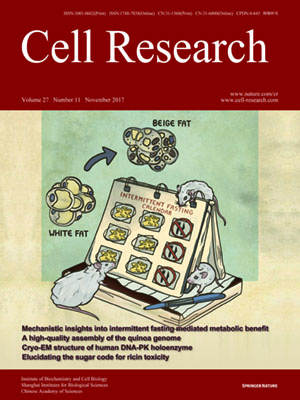
Volume 27, No 11, Nov 2017
ISSN: 1001-0602
EISSN: 1748-7838 2018
impact factor 17.848*
(Clarivate Analytics, 2019)
Volume 27 Issue 11, November 2017: 1378-1391
ORIGINAL ARTICLES
Structural and mechanistic insights into the biosynthesis of CDP-archaeol in membranes
Sixue Ren1,*, Antonella Caforio2,3,*, Qin Yang1,*, Bo Sun4,*, Feng Yu4, Xiaofeng Zhu1, Jinjing Wang1, Chao Dou1, Qiuyu Fu5, Niu Huang5, Qiu Sun1, Chunlai Nie1, Shiqian Qi1, Xinqi Gong6, Jianhua He4, Yuquan Wei1, Arnold JM Driessen2,3 and Wei Cheng1
1Division of Respiratory and Critical Care Medicine, State Key Laboratory of Biotherapy, West China Hospital of Sichuan University and Collaborative Innovation Center of Biotherapy, Chengdu, Sichuan 610041, China
2Department of Molecular Microbiology, Groningen Biomolecular Sciences and Biotechnology Institute, University of Groningen, Nijenborgh 7, 9747 AG Groningen, The Netherlands
3The Zernike Institute for Advanced Materials, University of Groningen, Groningen, The Netherlands
4Department of Life Science, Shanghai Institute of Applied Physics, Chinese Academy of Sciences, Shanghai, China
5National Institute of Biological Science, Number 7 Science Park Road, Beijing 100084, China
6Institute for Mathematical Sciences, Renmin University of China, Beijing, China
Correspondence: Wei Cheng, Tel: +86 18215660676 E-mail: chengwei669@scu.edu.cn; Arnold JM Driessen, Tel: +31 50 363216(a.j.m.driessen@rug.nl)
The divergence of archaea, bacteria and eukaryotes was a fundamental step in evolution. One marker of this event is a major difference in membrane lipid chemistry between these kingdoms. Whereas the membranes of bacteria and eukaryotes primarily consist of straight fatty acids ester-bonded to glycerol-3-phosphate, archaeal phospholipids consist of isoprenoid chains ether-bonded to glycerol-1-phosphate. Notably, the mechanisms underlying the biosynthesis of these lipids remain elusive. Here, we report the structure of the CDP-archaeol synthase (CarS) of Aeropyrum pernix (ApCarS) in the CTP- and Mg2+-bound state at a resolution of 2.4 Å. The enzyme comprises a transmembrane domain with five helices and cytoplasmic loops that together form a large charged cavity providing a binding site for CTP. Identification of the binding location of CTP and Mg2+ enabled modeling of the specific lipophilic substrate-binding site, which was supported by site-directed mutagenesis, substrate-binding affinity analyses, and enzyme assays. We propose that archaeol binds within two hydrophobic membrane-embedded grooves formed by the flexible transmembrane helix 5 (TM5), together with TM1 and TM4. Collectively, structural comparisons and analyses, combined with functional studies, not only elucidated the mechanism governing the biosynthesis of phospholipids with ether-bonded isoprenoid chains by CTP transferase, but also provided insights into the evolution of this enzyme superfamily from archaea to bacteria and eukaryotes.
10.1038/cr.2017.122
FULL TEXT | PDF
Browse 2049


